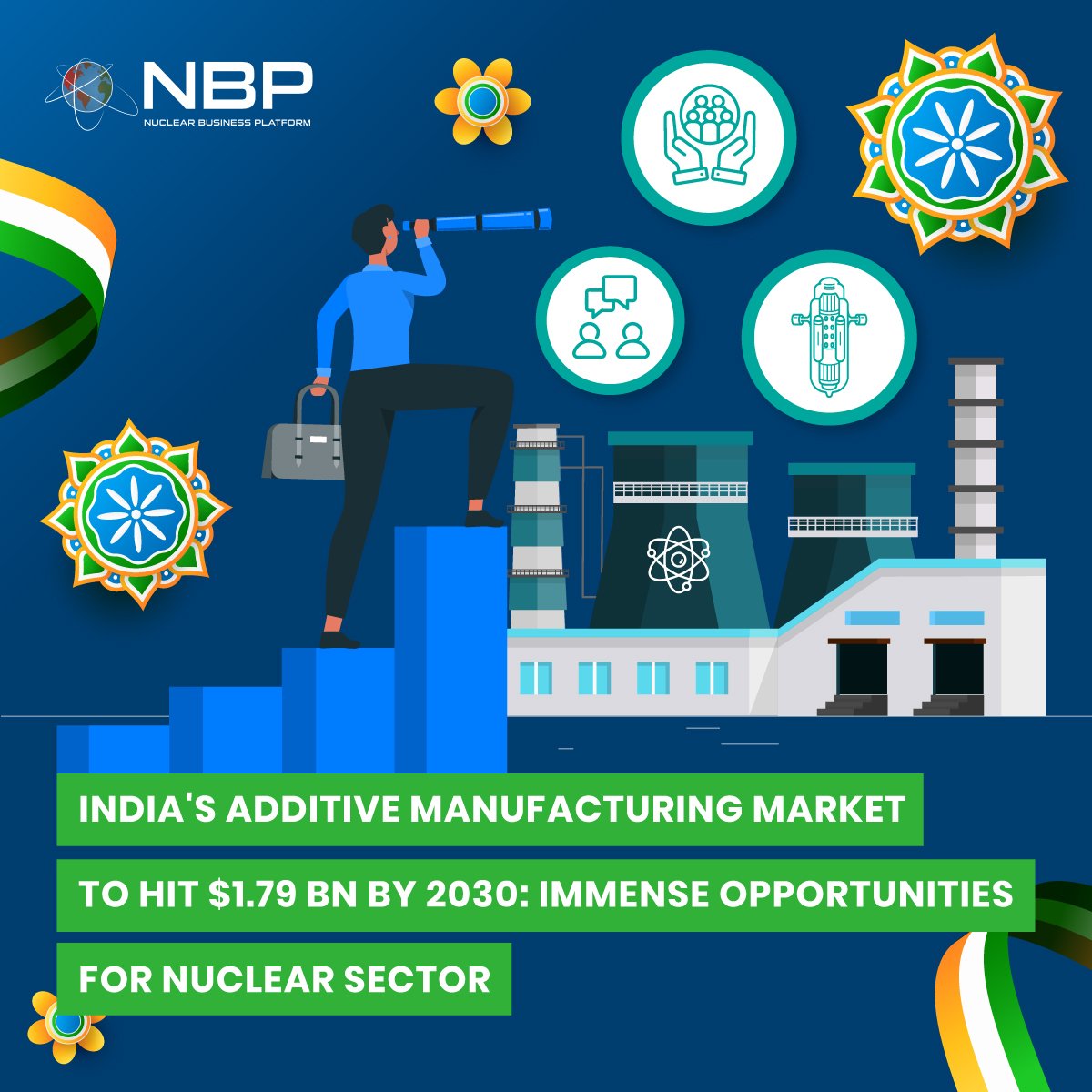India's Additive Manufacturing Market to Hit $1.79 Bn by 2030: Immense Opportunities for Nuclear Sector
India's nuclear energy sector is on the cusp of a significant expansion. With India's nuclear power capacity is targeted to reach 100 GW by 2047, the nation's nuclear industry presents a lucrative arena for advanced manufacturing of nuclear manufacturing services. Additive Manufacturing (AM), also known as 3D printing, is emerging as a game-changer in this growth trajectory. This technology offers a unique set of advantages that can revolutionize the design, production, and maintenance of nuclear components, fostering greater efficiency, safety, and cost-effectiveness. There exist immense potential of AM in India's nuclear energy sector, highlighting its benefits, government initiatives promoting its adoption, and its suitability for small modular reactors (SMRs) – a promising clean energy solution for India
What Benefits Can Additive Manufacturing Provide for Nuclear Sector?
AM is about building 3D objects layer by layer from digital designs, offers unique benefits in the nuclear industry. It enables the creation of complex components like cores, turbine blades, and fuel assemblies with optimized designs and improved performance. Here's how it's shaping the future:
Design Flexibility: AM frees nuclear designers from traditional constraints, allowing for innovative shapes and structures that enhance efficiency and performance.
Materials Innovation: By integrating advanced manufacturing with computational sciences, the industry can swiftly develop and validate materials suited for nuclear environments, moving away from decades-old materials.
Streamlined Certification: The layer-by-layer approach of AM generates extensive data, facilitating quicker certification and deployment of new parts with better understanding of their performance.
Real-time Monitoring: Embedded sensors in additively manufactured components enable real-time monitoring, offering insights for preventive maintenance and potential autonomous operations, enhancing safety and efficiency.
Speed and Cost Efficiency: AM revolutionizes component production, slashing lead times and costs compared to traditional methods. It crafts precise, durable parts crucial for nuclear safety and facilitates the creation of radiation-resistant materials for maintenance in radioactive environments.
Government Initiatives
The Indian government has fostered AM development through initiatives such as "Make in India" and the National Strategy for Additive Manufacturing. These efforts focus on research, skill enhancement, and infrastructure to create a supportive environment for AM growth. India has witnessed substantial AM adoption, projecting a market value of USD 1.79 billion by 2030, with a strong CAGR of 28.1%. Financial incentives and subsidies have accelerated AM integration across diverse industries, spurring innovation and growth. Government support for startups and SMEs has incentivized investment in AM, further driving growth. The National Strategy for Additive Manufacturing aims to capture a 5% share of the global AM market by 2025. This involves developing India-specific technologies, fostering startups, creating new products, and training skilled workers. Initiatives include establishing an AM Innovation Centre, developing a National AM Talent Pool, and promoting R&D.
Handy for SMRs
In 2022, the IAEA launched the Nuclear Harmonization and Standardization Initiative (NHSI) to expedite the safe deployment of advanced nuclear reactors and small modular reactors (SMRs), aiming to establish common approaches to nuclear standards, including those applicable to AM for SMRs.
India is increasingly interested in SMRs as a clean energy solution and views them as promising. AM offers significant potential for SMR deployment in India, enabling the production of customized components with reduced waste and streamlined production. SMRs, designed to be compact and modular, are well-suited for AM's ability to create intricate, tailored components. This technology allows for the production of highly customized parts with complex geometries, aligning with the specific design and configuration requirements of SMRs.
Global Advancements in Additive Manufacturing in Nuclear Technology
Oak Ridge National Laboratory (ORNL) in the United States showcased a breakthrough with a 3D-printed reactor core prototype, developed in just three months.
Ultra Safe Nuclear Corporation announced a collaboration with ORNL to leverage AM, particularly Binder Jetting, to advance micro modular reactors.
ČEZ, a Central and Eastern European utility company, optimized its nuclear supply chain with AM in collaboration with Škoda JS, enhancing efficiency and reducing downtime.
Browns Ferry Nuclear Plant in Alabama utilized 3D printing for critical components, such as fuel assembly brackets, demonstrating the technology's reliability and safety in nuclear applications.
Siemens pioneered the use of 3D printing in nuclear power plants with the production of a metal impeller for a fire pump at the Krško plant in Slovenia, showcasing the technology's operational capabilities.
Westinghouse Electric Company introduced industry-firsts with 3D-printed components, including a thimble plugging device installed in a nuclear reactor, highlighting the technology's potential for innovation and efficiency.
Framatome, a French nuclear firm, successfully developed and installed a 3D-printed stainless steel fuel assembly component at a nuclear power plant in Forsmark, Sweden, marking a significant milestone in AM's application to nuclear energy.
India’s Nuclear Landscape
India's nuclear energy sector currently contributes 3% to the nation's electricity generation. With a target of 9% by 2047, there are 23 reactors in operation, totaling 7.48 GWe. Additionally, 12 reactors under construction (9.4 GWe), eight with financial approval (5.6 GWe), and 18 with preliminary government approval (24 GWe) signal a significant pipeline, totaling 46.48 GWe. Furthermore, aiming for 100 GWe by 2047, India is emerging as an attractive market for nuclear investments.
Therefore, the convergence of AM and India's burgeoning nuclear energy sector presents a wealth of business opportunities for companies established in the AM sector. With the Indian government's strong support, coupled with the country's ambitious nuclear energy expansion plans, the demand for advanced manufacturing solutions is poised to soar.
The 5th edition of India Nuclear Business Platform (INBP) will take place in Mumbai this 19-20 November 2024. The industry meeting will feature all the officials and players across the Indian nuclear supply chain. For more information on this meeting including exhibition opportunities, click here



